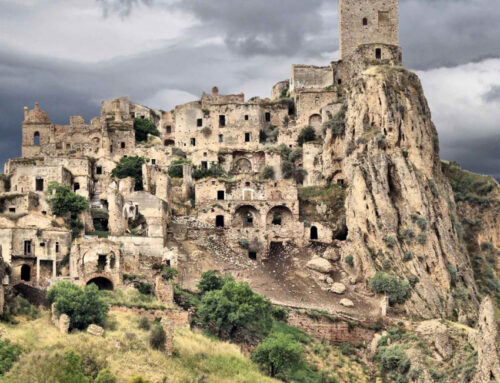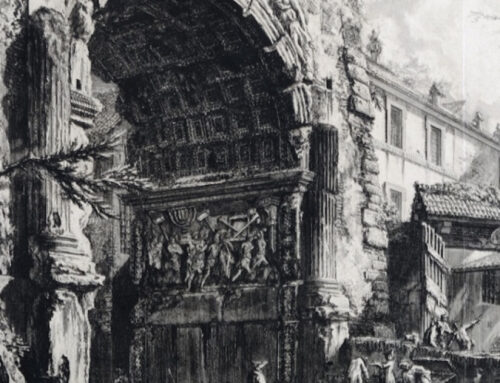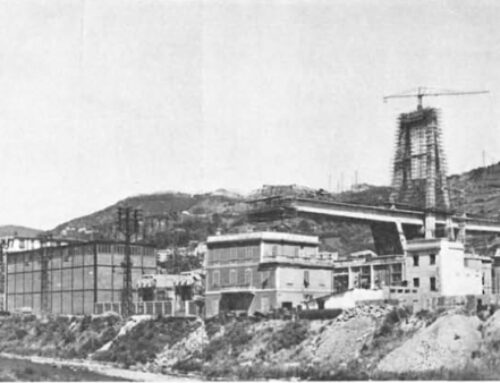Before getting to the heart of what landscape can do for culture and for enjoying culture, I would like to make a point about the relationship between culture (or rather cultural design) and landscape, which probably allows for a better understanding of the reasoning that follows.
Culture (or rather good cultural design) can help to build the gaze capable of reading the landscape – especially in compromised and anonymous places, where an extra code and information context is required to decode and interpret the text – and can help to turn the spotlight on resources at the margins, little used and explored. Culture and cultural heritage should help both inhabitants and tourists to read landscape elements within the territory.
Cultural heritage and cultural activities can, that is, provide people with the keys to reading, interpreting and ‘surfacing’ landscapes. This is on the condition that the cultural system is capable of providing ‘mediation’ apparatuses that are not only ‘internal’ to the cultural object and self-referential in logic, but that provide communication and mediation systems capable of effectively and captivatingly conveying the complexity of the heritage, the genius loci, the transformations that have occurred and those underway.
Coming to the request of the seminar, namely what landscape can do for culture, I would like to share a few themes: –
1. Landscape as an antidote against a certain attitude of culture-making that museifies the existing and against the gaze that petrifies
2. Landscape as an antidote to the perverse effects of territorial and tourism marketing when constructing destinations conceived as necklaces of memorable episodes (in the user’s experience) often disconnected from the context or indifferent to places.
3. Landscape as a resource for storytelling and the production of meaning in relation to changes in the present, as material for the production of new imaginaries.
4. The landscape as a space for action within which to experiment new forms of sustainability and new modes of intervention oriented towards producing economic development.
1. Precisely because the landscape is a space for action and transformation, and because of the capacity of the landscape to live, as Kerényi would say, in a ‘double contemporaneity’ of present and past, of nature and culture, it can help combat the risk of the museification of the existing and the gaze that petrifies everything it sees, i.e. two effects of a certain type of cultural design and attitude. I am talking about that type of cultural design – understood both as the realisation of hard interventions for the conservation and transformation of heritage and the built environment, and soft as the realisation of events and activities, but also as the production of atmosphere, of milieu – that has very often produced the museification of historic centres (whether major or minor). A centre that becomes a museum of itself is a centre that abdicates producing meaning for its inhabitants and in time risks no longer producing any for tourists either. If cultural planning is closely related to the landscape, it cannot but introject a dialectic – even a contradictory one – between past and present, between the often conflicting needs of those who inhabit, use and enjoy an area, between the problems of careful conservation of the past and those of sustainable management of the present.
2. Mitigating certain effects of territorial marketing
When territorial marketing action uses culture (the good, the widespread heritage, the event) as a more or less qualified factor of attraction in the construction of the destination it uses it – almost always – simply as one of the elements of organisation of the territory (one of the functional elements to organise time and routes). This can lead to a weak and often counterproductive relationship between property and landscape.
When this relationship is weak, in fact, an intermittent mode of enjoyment and enjoyment is produced, made up of clusters of gazes, in which the aesthetic intention is aroused ‘on call’ only in the presence of a monument, a well-lighthouse or a recognised foreshortening, only to then return to slumber in the ‘transition phases’ between one salient moment and the next. This runs the risk of first of all depotentiating the enjoyment of the landscape in its complexity and richness (that complex landscape, often difficult to recognise and interpret, found in the transitions between one salient moment and the next). Indirectly it also disempowers the cultural good, especially where the good is ‘isolated’ and surrounded by anonymous or de-qualified landscapes, where the approach to the good is a moving between warehouses, industrial areas, signs, shopping centres.
On the other hand, one of the things that the evolved cultural tourist (but also the evolved inhabitant) seeks is the possibility of creating and consuming/enjoying the landscape within the territories, of exploring new routes, of searching for beauty, the sense of discovery and authenticity even outside the canonical and obligatory destinations of art tourism. In this type of experience, therefore, it becomes unnatural to separate the fruition of the good or the enjoyment of a cultural experience from the context in which it takes place. Because the cultural moment is inseparable from others within a pleasurable sequence of actions and moments.
This differentiates it from other types of travel and travellers (in whose palimpsest the cultural good and event may also appear) in which the reassuring search for an organised territory predominates (to move around, to eat, to sleep, to be entertained, to experience culture, etc.- cruise passengers for example).
Landscape helps and serves to enjoy culture because it places it in a more articulated and complex horizon of enjoyment, in a less stressed horizon of experience. It helps to remove the cultural asset from the obsession with the tourist destination, it helps to produce alternatives, it suggests routes that decongest traffic and flows, it provides alternatives for the gaze that would otherwise be all over the asset with the problems of load that we know so well in our cities of art or in the strong seasonality of our tourist destinations. Heritage refers to new landscapes, but the landscape in turn returns different and unexpected cultural heritages. It slows down time, distracts from the main roads.
3. The landscape must continue to be a resource for the imaginary and the production of meaning, which manifests itself in various ways, one of which is the production of narratives. I am thinking of the novelists who have created the landscape: the Langa of Pavese, Fenoglio, Layolo, Camilleri’s Sicily, Vasquez Montalban’s Barcelona. I am also thinking of certain photographers such as Olivo Barbieri, who with his site-specific interventions has narrated the perturbing areas and the landscape of the Po Valley. The landscape is interpreted by the novelist/artist and becomes in turn a key to a return in a virtuous circle that must be continually nurtured.
Another theme is that the landscape must become the privileged habitat of storytelling, where cultural communication and artistic language are applied to the design of enhancement routes that allow tourists and hikers to explore little-known landscapes, often not immediately readable or in which there are no recognised landmarks or attractive factors, but rich in history and stories.
4. The landscape as a space for action in which culture can experiment with new forms of sustainability and new modes of intervention geared towards producing economic development
This is perhaps the most challenging point and the furthest from having a defined and shared operational framework.
The landscape can be an opportunity if we evolve the model that has seen Culture use the landscape mainly as a precious ‘backdrop’, as a suggestive and unusual backdrop or stage within which to place its actions. A conservative relationship is established, one of defence, if anything, of the income from the position that a beautiful landscape guarantees: the eye of Niemeyer’s auditorium in Ravello points to the same stupendous sunset that has never betrayed generations of spectators and tourists who have waited for dawn at Villa Rufolo while listening to Wagner or Mozart.
This type of income may guarantee a surplus of sales price or a surplus of audience, but it will not eliminate the weaknesses and threats that are increasingly being directed towards a certain model of cultural production highly dependent on the public hand, conceived as a service to the community that produces costs and often fails to make the benefits evident.
Landscape can serve to force some ‘blocks’ that seem to ballast possibilities for different developments. In fact, landscape would make it possible to create an alliance between operators belonging to different stages of the supply chain or to traditionally uncommunicative sectors (primarily private and public).
The landscape becomes that intermediate entity in which different subjects can recognise themselves (cultural operators, hoteliers, wine and agricultural producers, tourism, etc.) and on which to carve out new governance models capable of ‘holding’ in the face of higher levels of complexity and of providing a shared vision within which to provide inter-institutional and intersectoral representation and the possibility of mediating and compensating for specific objectives and instances.
The landscape thus becomes the territory’s software that enables alliances and partnerships for the pursuit of objectives that would be unlikely to converge.
To use the landscape as an operational context means for a museum, for example, to work in a network with all the subjects in the area, from agricultural associations, to businesses, to the third sector, to the voluntary sector, in a logic of co-partnership and partnership within a system of governance that is at a higher level and on a broader scale.
It is difficult to find many examples in our country of experiences that are moving in this direction. Perhaps an interesting example, although still at an embryonic stage (and therefore difficult to assess) is that of the district mechanisms promoted in Lombardy by the Cariplo Foundation. These are models that, due to their highly process-oriented nature, the use of multi-level governance solutions and the presence of both in itinere and ex post evaluation moments, are highly innovative in our panorama and as such are not immune from difficulties and resistance, including of a cultural nature. The first, as we know, is that of the Camonica Valley, which has already started several years ago the construction of a ‘unitary landscape’, the object of comparison and sphere of action of the various institutional subjects and the variegated territorial representations. The networks and cultural themes that have emerged (from megalithism, to Roman culture, to the industrial museum) have been defined with the agreement and contribution of all the subjects starting from this initial recognition. The governance instrument is that of the associated office.
I would like to conclude with one last example that is linked to our territory and refers to the recent legislative innovations introduced by the Piedmont Region in 2009 through the framework law on financing culture, Law 58/1978. In recent years, the Regional Directorate for Culture has been trying to stimulate, more decisively than in ordinary practice, the construction of heterogeneous territorial networks, in which the museum/cultural heritage is synergically interconnected – not only on paper but in actual territorial practice – with different operators and sectors: agri-food production, handicrafts, tourism, environment, social associations, etc. Consequently, in recent years, thanks to its collaboration with Piedmont’s cultural observatory and the involvement of a network of consultants who are experts in the dynamics of territorial development, the Region has gradually defined what may be considered a programme of accompaniment to the territories articulated on two levels: one financial and one more methodological. And, since working in the area is difficult and building networks requires skills and aptitudes for mediation and synthesis that are anything but banal, the areas covered by the programme can benefit from a support service provided by the Region through a network of its consultants – all operators with previous experience in territorial planning – who go to the areas and support the animators in their activities, assess their work, try to bring out local projects and possible interconnections, especially between different production sectors and activities. Specific training needs are emerging – and this conference has also been included in the current training programme – precisely because there has been a strong interest on the part of local operators in the landscape, in order to understand what the landscape is outside the rhetoric that makes it a must, an essential value for any territorial project centred on cultural heritage, without, however, being clear about its real impact and, therefore, its possible repercussions in economic, social and cultural terms.
Alessandro Bollo
economist, Piedmontese, manager of the Fitzcarraldo Foundation





